The Great Replanting II: Aesthetic Considerations
Messes, hedgeballs, and linear efficiency
Hey y’all! The following piece is the next part of a continuing series on agroforestry adoption that I’ve had in my head for awhile. If you didn’t read part one, it might benefit your enjoyment of part two to do so. You might also brush up on your Osage orange knowledge!
We built our home in the thorny embrace of an old hedge tree, a sprawling spray of hardwood tendrils that bend in autumn wind, its battered and bug-eaten leaves trembling with the slow creep of icy death. If I had to make a guess, I would contend that this tree drops 400 pounds of seed in the form of “hedgeballs” each year. They are dense and green, weeping white latex as they careen downward and slam on the tin roof of our farmstand, echoing the rifle-blasts of deer season that ring out among our rolling slopes of patchwork woodland and open pasture.
Before we built our home here, this mother tree stood, perhaps intentionally planted on this old fenceline, or maybe risen from the squirrel shit lining the base of old wire-tangled posts. It shelters us now, breaking the winter wind and blocking snowdrifts some of the season, shading our home from the burning heat that only gets hotter for the rest. When we hired an excavator all those years ago to dig out the foundation of our home, I built ramparts up along the trunk of the old hedge tree to protect it. One of our first duck hens (we had livestock before we had a house for some reason) was setting a nest under the dense shade of the old hedge tree, the breast feathers she plucked for her nest lining flitting in the tangle of gooseberry thorns underlaying the canopy.
As the teenage Mennonite boy hired to dig our home site pushed aside dense hillocks of orange clay to make way for our house with a 6 ton excavator, my rickety assemblage of pallets and baling wire held the front between the generative environment of root, thorn, and bark and the diesel-powered destruction of long-resting earth. Later that summer, ducklings would hatch out in the haven of wood and leaf. By October, we had appropriate shelter –400 square feet of indoor living space, insulated by straw and earth, makeshift shelves lined with pressure canned jars of duck meat– and a considerable repository of Osage orange seed in the form of heavy green fruit pelting us from above.
Any sensible farm family would have cut this tree to its base before building here. While the proximity to a tree that could potentially wipe out our roof in the wrong wind is certainly one reason, the risk of traumatic brain injury by hedgeball is probably statistically higher, let alone the likelihood of tripping on one. Like a lot of trees, Osage orange makes what “civilized” Americans refer to as a mess. Civilized Americans strongly prefer a tree that keeps in line– symmetrical, predictable pines and firs, impotent little dwarf ornamentals, boring boxwoods, and status-seeking Norway maples with their flashy crimson displays. Trees that know their place and don’t cause any inconvenience. Further outside suburbia, in agricultural zones like Northeast Missouri, trees are still largely considered an inconvenient mess.
I have met many a cattle rancher who will cut the hedge from their pasture because they claim the cows choke on the hedgeballs. I won’t rule out the possibility, but I have yet to hear of a confirmed first-hand account. To all those readers who might argue counter to this, I politely remind y’all that this is Missouri, so you’re going to have to Show Me. Still, I’ll acknowledge that hedgeballs can be real ankle breakers sometimes. I have a fading memory of skidding out on my bike as a kid while trying to navigate a sidewalk covered in hedgeballs– we used to call them “monkey brains” for some reason.
This is all to say that for all the benefits trees offer us, they come with their inconveniences. We cannot merely enjoy the shade, wind protection clean air, carbon sequestration, soil health, habitat, food, lumber, and firewood they provide without tolerating the “mess”. If we want to continue existing on a liveable planet, we’re going to have to choke a cow or two, or at the very least bust our asses tripping on hedgeballs from time to time.
I’m going to be honest with you– for all the carefully cropped images you see here in the Almanac, my homestead objectively looks like dogshit most of the time. It isn’t a seasonal thing either, it’s year round. It looks particularly bad today, but as an amateur photographer, I mostly know how to avoid sharing some of the more shameful aspects of my landscaping aesthetic. Aesthetics never meant much to me. I’ve always preferred functionality. But aesthetics do mean a lot to other people… and practically-minded Midwesterners are no exception. Perhaps this is a piece of why we’ve struggled to embrace trees as a part of the agricultural landscape here.
One many several occasions, when chatting with local folk at our little diner here in Rutledge, I will be asked where it is that I’m farming, and when I reveal my location, the response is: “Y’all sure grow a lot of brush!” In the Midwest, vegetation that can’t be planted in rows, mown or run through a combine is called brush. What cannot be controlled is to be feared, and this is understandable, given the many opportunities I have to break my ass or receive a concussion right in my own yard, from our mother tree. I surmise that this is a largely Euro-settler viewpoint, passed on through the generations to become things like precision agriculture, or the lawn care industry– landscapes evolved out of fear, artifice, and domination.
Imagine if you will, the work of clearing timber and plowing the prairie during early settlement. No herbicides, no internal combustion, just draft animals and moldboard plows. The level of toil and drudgery and potential bodily harm that earlier generations had to endure to cultivate profitable land here was exceptional. When the work was done– the timbers felled, the stumps burnt, the wild grass uprooted and buried– settler families looked on their work with pride, probably having no contextual understanding of the deep history of damage and extraction they had begun to create.
Watching their work fade as the native ecosystem they struggled to tame regenerated itself would have been unthinkable, and from that time forward no future generation would want to be viewed as the one that let things get weedy again. In the agrarian Midwest, if your great-grandaddy cleared a field, growing a lot of brush is something of a taboo. A serious one at times.
As far as old-timers go, our part of Missouri was settled by uppity Kentuckians who wanted a bigger piece of the new frontier, and are therefore largely of Scots-Irish descent. However, Missouri and the Midwest in general was settled and homesteaded by a lot of German immigrants as well, and I think I’m probably allowed to say that Germans are known for having a fairly high degree of tidiness. Sometimes pathologically so. Take for example the spate of German-immigrant housewife suicides that took place during the Dust Bowl era. The inability to maintain a clean house during the torrents of dust-storms that continually left every surface in the home in a layer for fine, wind-blown Earth has been cited as a major factor in this phenomenon. Some of these people could not bear the constant stream of dust any longer. People who truly chose to place cleanliness next to Godliness.
While times have changed, and we’ve somehow managed to avoid another major Dust Bowl event thus far, I really do think this compulsion to create and maintain a degree of aesthetic order on the farm is a significant part of why we don’t see much needed trees on the Midwestern agricultural landscape, and when we do, they are often hemmed in by the severe human boundaries imposed on them.
While I distinguish aesthetics from functionality, there is something to be said about form following function. While the human eye is naturally drawn toward patterns and lines, I think the reason that farmers find particularly straight lines the prettiest is because a straight-line increases a narrow economic margin. Straight lines are efficient in terms of labor, fuel, and resources. Sometimes I like a nice straight line of crops myself, to be honest. Mostly if they’re my own. A disruption in that line is a visual reminder of a shrinking yield and a smaller paycheck.
The stakes are increasing as we enter the era of “precision ag”. AI operated harvesters, drone seeding and spraying, driverless, GPS guided tractors and increasing layers of technological abstraction being sold to keep farmers further away from their crops are not going to necessarily lead to more efficiency, so much as increased scale and decreased humanity. There is nothing precise about GPS in comparison with putting your damned feet on the ground and walking your field, as is the actual job of a farmer. Trees are inconvenient in precision ag. It’s part of why I like them. They require consideration.
How some folks are approaching agroforestry is to implement and promote tree plantings that mirror this modern linear-efficiency model, which may even mesh well with broad-scaled precision ag. I grudgingly acknowledge that this is a good strategy (and occasionally follow it), and important work to be doing. If farmers normally see a tree in their field as an economic inefficiency, sometimes the only way they can be convinced of the potential economic boon in tree-cropping is to put those trees in straight lines. Straight lines equal dollar signs to the modern agrarian brain, and this impulse is tangibly correct in our current mainstream system.
At best, we find the type of diversity and complexity that we need to balance our current agricultural activities on the margins. Oddly shaped tracts of land, broken chains of old hedgerow, and steep creek-side banks are where I go to find the rarest birds, the most precious trees, and the most cover from elements when I’m out there with my own damned feet on the ground. These areas are often chaotic– I emerge from them covered in burs most of the time, and I can loose myself stepping through the brambles and thickets arising in the regrowth and neglect.
I don’t consider myself an optimist, but I’m always hoping for the best. I usually work for it too. I believe that tree-crop based agriculture has a large role in a sustainable future, and that we are technically capable of transitioning to it before we’re entirely doomed. But unlike earlier projects like the Great Plains Shelterbelt, I don’t think the political willpower to fix catastrophes by applying common sense practices exists in this country anymore. The solution will be decentralized, growing from the margins, and it won’t be very tidy.
The rain today is icy and driving, piercing the thinning canopy of our mother-tree, taking battered leaves and fat hedgeballs down to the cold clay. Our most recent flock of young ducks, great-great-great-grand-ducks of those who were hatched here at the base of this old hedge, is waddling and nibbling through the bucket-strewn middens of our yard. As they grow bigger, they leave more of a mess, get a little less cute. Newly hatched ducklings are objectively aesthetically pleasing. The muddy teenagers, not as much. But I don’t feel any fear here.
Every once in awhile I might get clocked in the head by a hedgeball, or caught up in some thorns, and my neighbors might snicker (or worse) about our little brush farm. But I do have lots of food, and roots to hold the sweet earth, and rugged boughs of Osage orange to hold and protect our home, which is more security than any straight line or clear field has given me to this point. We can try to build a world that appears tidy, but out past where the road faces, down in the margins, it’s a mess regardless. It all is. Better to manage and propagate the chaos that feeds creatures and creates homes, than to accept the order which denies these things to the most vulnerable.
But I do need to pick up some of these damn hedgeballs.
The Fox Holler Almanac is a reader-supported publication— I couldn’t do it without you! Share or leave a comment if you liked it. Hell, leave a comment if you didn’t, though I might ignore it. And if you feel moved and able to materially support my work, upgrade your subscription or buy me a coffee. Thanks, y’all.


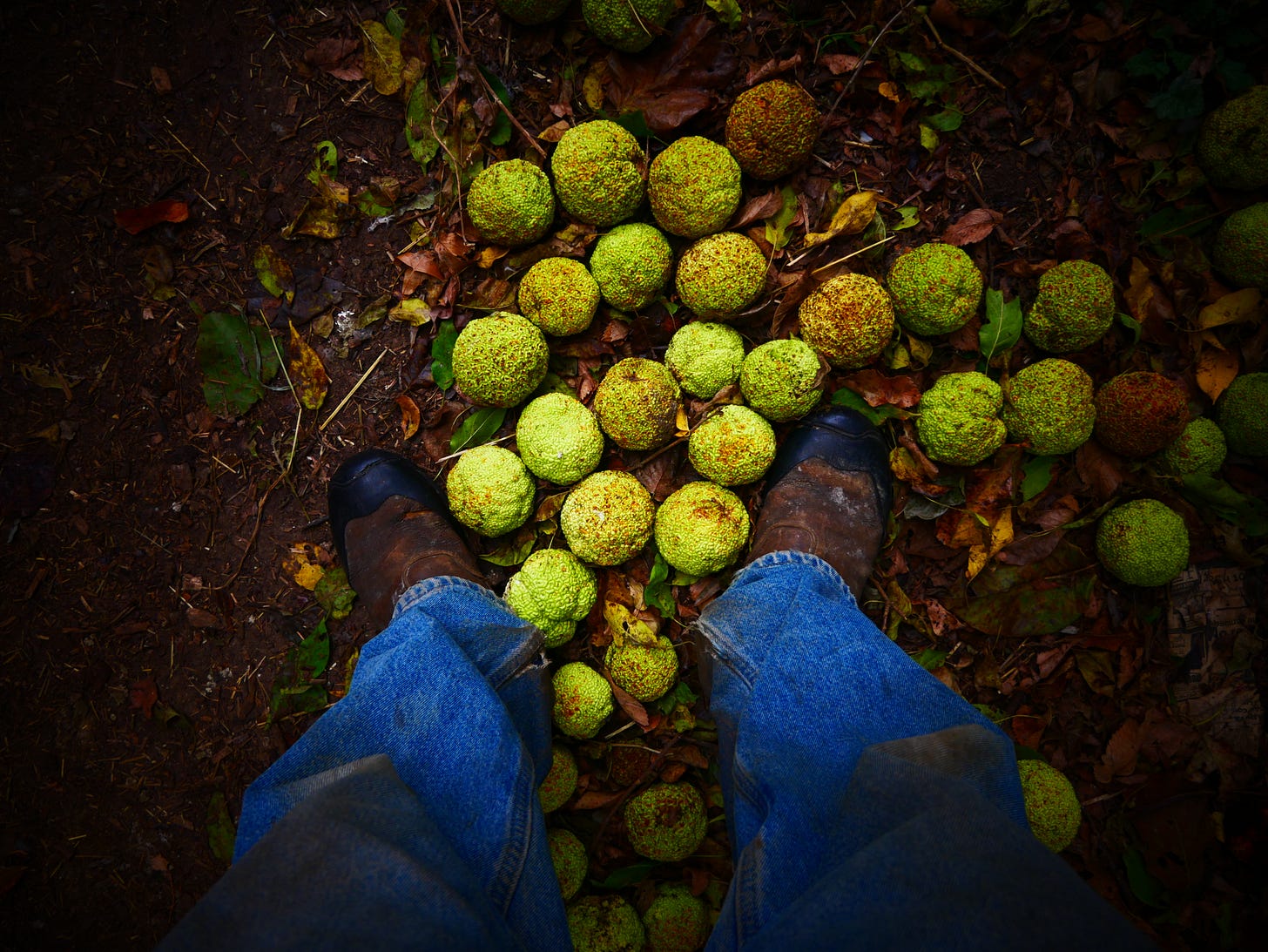
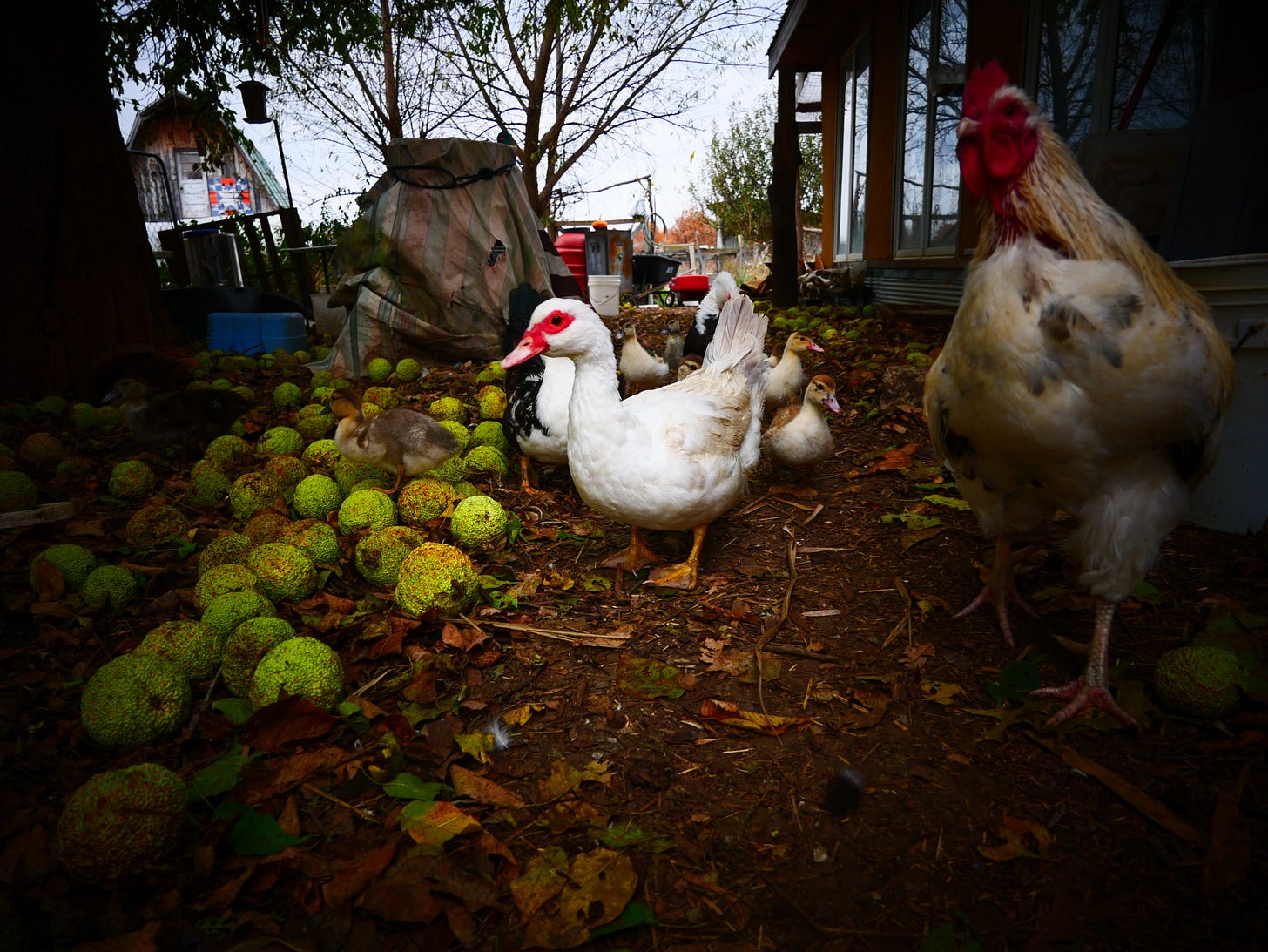
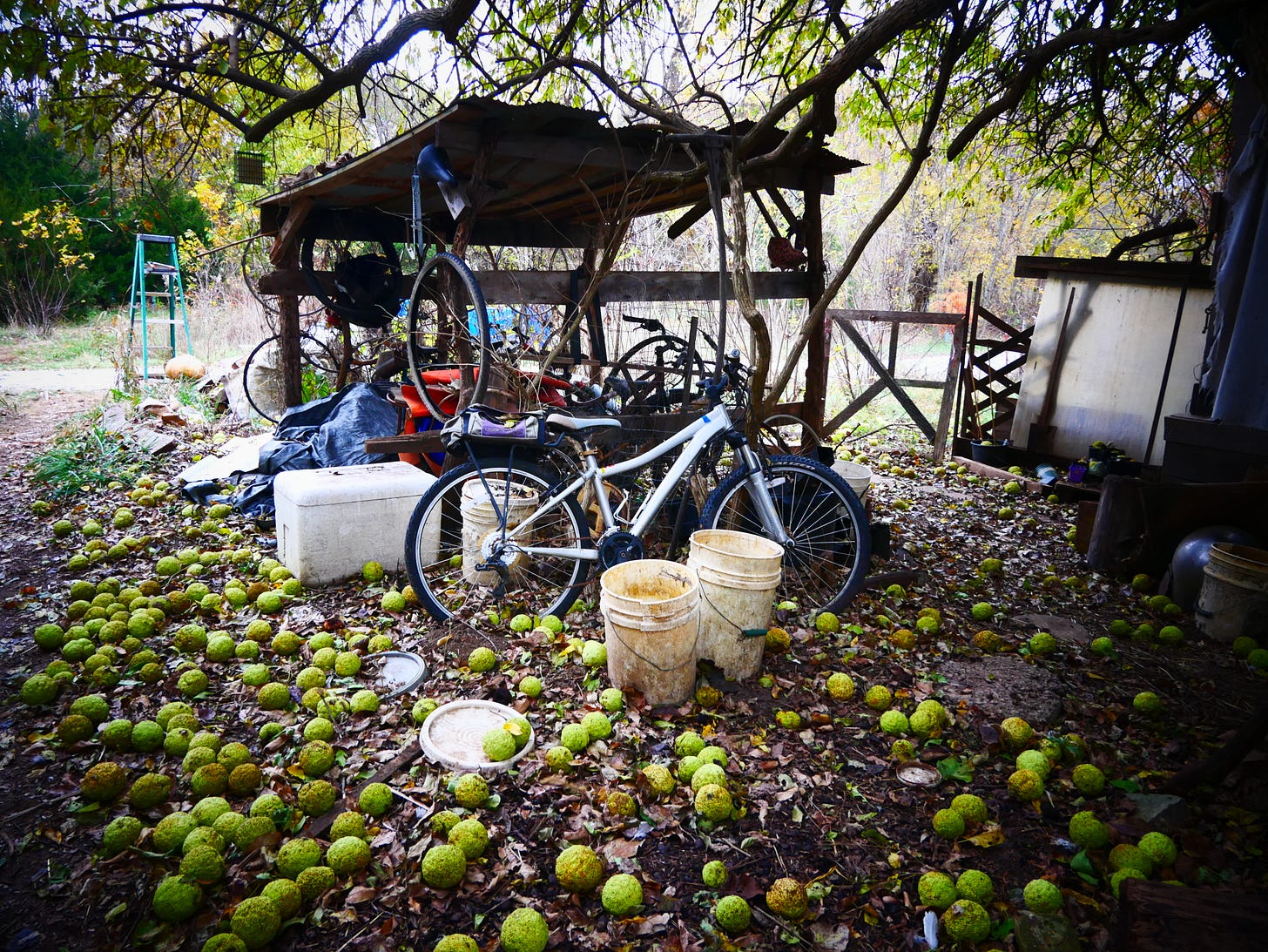
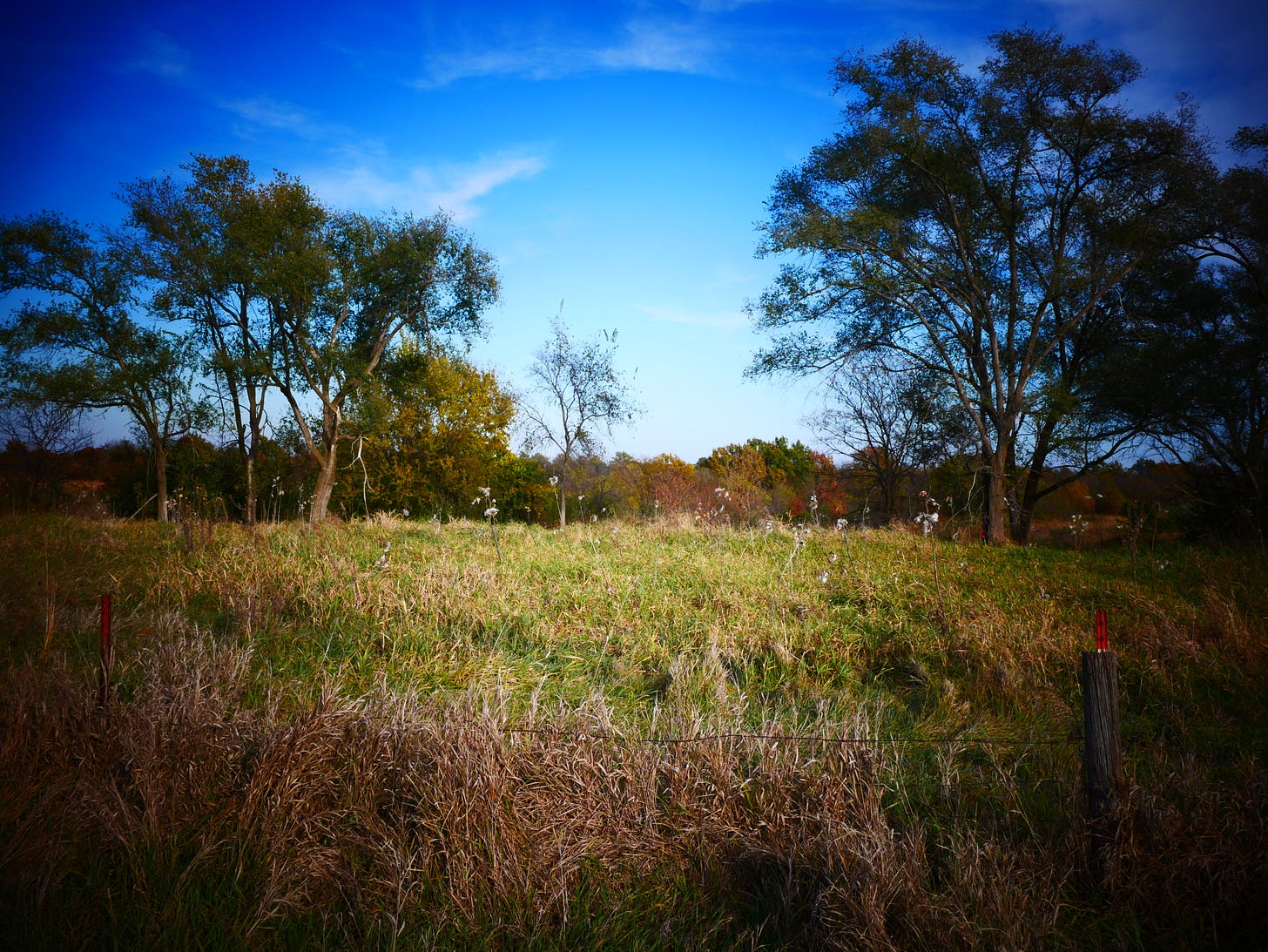
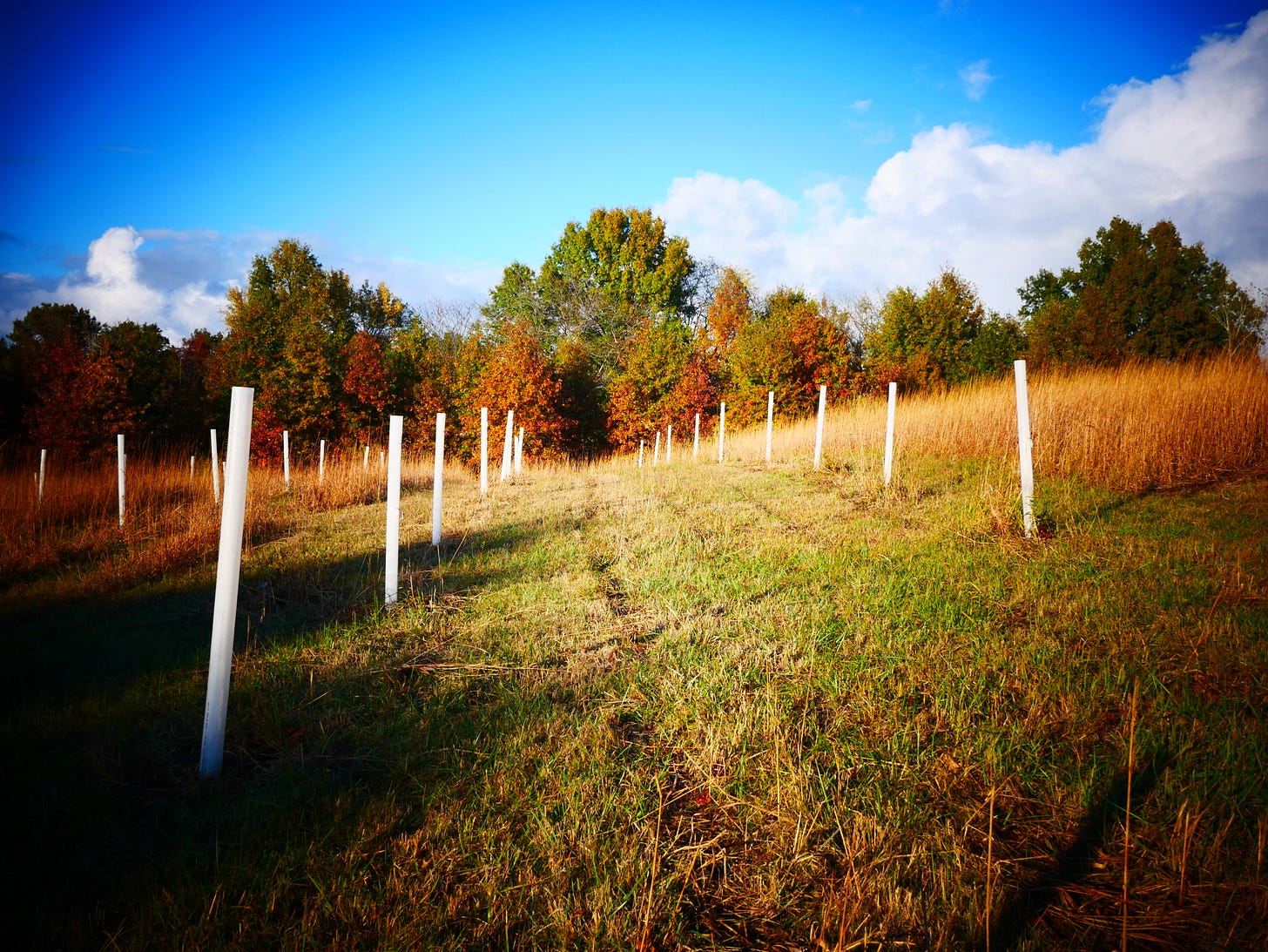
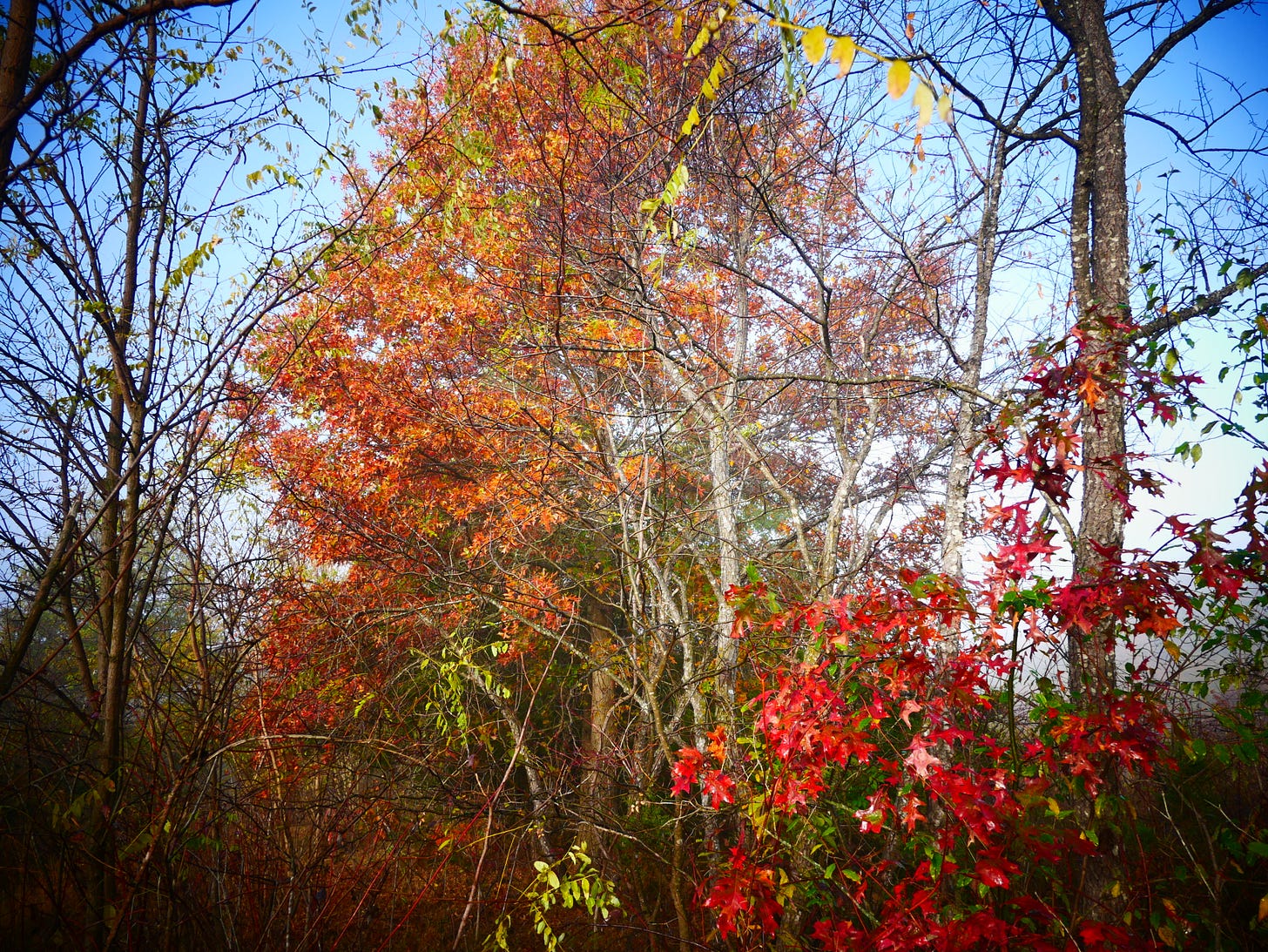
All that tidiness is terrifyingly sterile. How can anything survive in all those sharp lines?
This article really landed at the perfect time, I was just thinking about urban green spaces. I'm fascinated by the 400 pounds of hedgeballs you mentioned. While it sounds incredibly vibrant, does that massive ammount of organic material ever pose a... maintenance challenge, or does it integrate naturaly into the aesthetic you're aiming for?